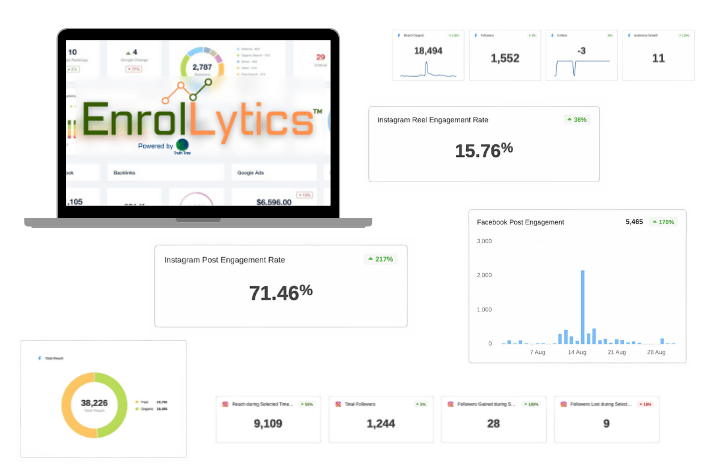By Maggie Twaroski, Truth Tree Contributor
From school shopping to community building, social media is an important outlet for both your prospective and current families. Even if you have a social media marketing strategy in place, getting the results you want is another task entirely. Fortunately, increasing your ROI and meeting your marketing goals is achievable when you start focusing on your KPIs.
Key performance indicators, or KPIs, are metrics that reflect how well your social media marketing supports your school’s goals–whether it’s bringing in new prospective families, increasing engagement, or elevated conversions–you name it. Tracking your KPIs ensures you stay on track and helps you make informed decisions about your strategy.
A common obstacle schools face when tracking KPIs is distraction. There are dozens of KPIs to consider, and it’s easy to get overwhelmed. The key is to decide which KPIs actually matter for your goals, then focus on those.
This could look something like this:
- Goal: Increase brand awareness
- KPI: Post impressions (the number of people viewing your content)
- Goal: Increase engagement with audience
- KPI: Number of comments, shares and likes
- Goal: Generate interest with prospective families
- KPI: Audience growth rate (the number of new followers to your channels)
How to track your social media KPIs
If you’re just beginning to track your social media KPIs, you may want to test the waters by checking each platform’s analytics individually. Facebook, Instagram, X, Youtube, and other popular social media platforms all have user-friendly, built-in dashboards with performance data. As you familiarize yourself with the handful of metrics that matter most to your school, tracking KPIs on individual channels can be a sustainable plan. But as you start looking at more advanced metrics across a larger number of channels, you may want to recruit help from a third party. Track social media metrics in GA4, Enrollytics™, or a social media management platform like Hootsuite or Sprout Social to keep your data in one place.

8 KPIs to track right now
It’s worth repeating–you don’t need to track every possible KPI in order to see positive results. To get the most of your analytics, carefully choose which KPIs relate to your marketing goals, and focus on those. For most schools, that list will include some or all of the following:
1. Audience growth
Gaining new followers is a positive sign that your social media strategy can effectively bring in new leads. If you’re just starting to track this KPI, you may be looking for any level of growth, but specificity is important. Make sure you clearly identify your targeted growth rate (2% per month, for instance), to make sure you’re staying on track.
Most analytics dashboards will automatically calculate audience growth for you within a given time period, but you can also calculate it manually with this formula:
Net new followers ÷ total followers × 100 = percentage of audience growth rate
2. Impressions
Post impressions are a good indicator of brand reach, as they show how many times your content appeared in someone’s social media feed. Not all of these impressions will be from qualified leads, but it’s helpful to know how much exposure your content receives.
The more impressions you have, the greater likelihood of gaining more followers, increasing brand awareness, and post engagement. Some social media platforms like Instagram will break down your impressions into followers and non-followers, so you can see how far your content reaches outside your network.
3. Engagement
Likes, shares, comments–these are some of the common ways users will engage with your content. These are important metrics, because they indicate how well your content can stop someone’s scrolling and encourage them to take action.
To track engagement, you can either group all your metrics together as a cohesive unit, or you can break it down into specific groups–x number of likes, x number of comments, etc. If you’re looking to get a basic read on how many people are stopping to read your posts, you can simply track your engagement metrics as a whole. If you’re trying to facilitate deeper connections with your audience, start tracking engagement metrics individually. Focus on those that require a deeper level of engagement, like comments.
4. Saves
In many ways, enrollment is a long game–taking weeks, months, and sometimes years for your prospects to go through the entire admissions funnel. Only a small percentage of your social media followers are ready to take action right now. The rest will be putting your school in their back pocket to revisit when they’re ready. That’s why “saves” (“bookmarks” on X, “watch later” on Youtube, etc.) are an important metric–they reveal how many people are saving your posts to their personal account. Not only is this a good indicator of how many people are interested in your school, it also shows your content is of good quality and worth saving.
5. Conversions
The majority of your social media posts should have some type of call to action, whether it’s clicking a link, sharing a post, or participating in a poll. Your conversion rate will tell you how many users took the desired action. If your conversion rate is low, try adjusting and A/B testing your CTAs to see which ones are most compelling to your audience.
6. Click-through rate
If your social post includes a link to a web page or landing page, you can track how many users are clicking on that link. This can tell you how much exposure your posts receive, how users respond to your CTAs, and with appropriate pixels in place, how they interact with your brand beyond the social channel.
7. Mentions
Nowadays, most word-of-mouth (WOM) marketing occurs online in the form of reviews, mentions, and shares. If WOM marketing is an important part of your enrollment strategy, you’ll want to start tracking that KPI on your social channels. Watch for users who mention or tag your school in their own social posts, or when they share your content to their own network of followers.
8. Referrals
Although social media is valuable in its own right, your leads will ultimately have to go to your school website before taking any concrete action (contacting admissions, scheduling a tour, registering for an event, and so on). When you track referrals in Google Analytics, you can see how many people are visiting your website from social media, and which platforms they’re coming from, down to the specific post. This can help you determine which social media outlets are most effective at bringing in referrals, and which ones need improvement.
Meet your marketing goals with KPIs
Don’t leave your social media marketing up to chance–make sure you’re staying on track by frequently assessing your KPIs. Decide which metrics align closest to your goals, whether it’s increasing engagement with your constituents, generating new leads, or increasing conversions. No matter your goals, social media KPIs will help you assess how well your content performs, so you can make any necessary strategic adjustments.
Is Partnering with Truth Tree Right for Your School?
Our team has supported schools of all sizes and types as they aim to grow their enrollment, strengthen their retention, and solidify their digital footprint.
How could our skills impact your school?
